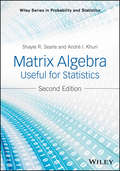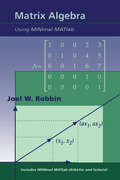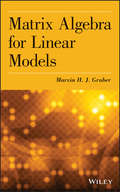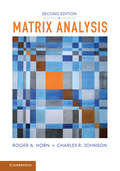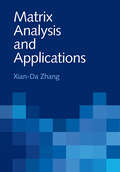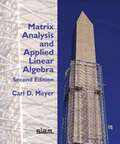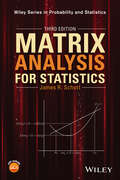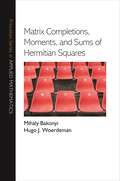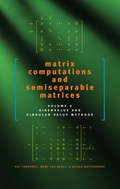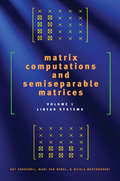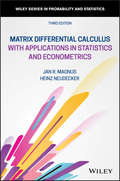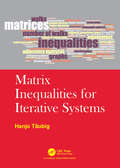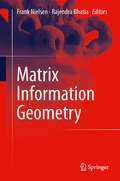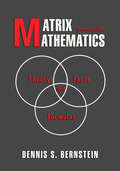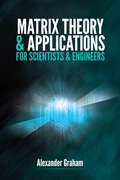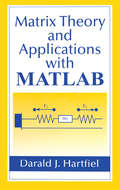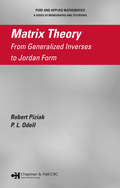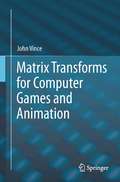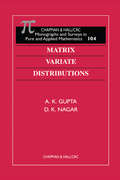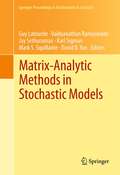- Table View
- List View
Matrix Algebra Useful for Statistics
by Shayle R. Searle Andre I. KhuriA thoroughly updated guide to matrix algebra and it uses in statistical analysis and features SAS®, MATLAB®, and R throughout This Second Edition addresses matrix algebra that is useful in the statistical analysis of data as well as within statistics as a whole. The material is presented in an explanatory style rather than a formal theorem-proof format and is self-contained. Featuring numerous applied illustrations, numerical examples, and exercises, the book has been updated to include the use of SAS, MATLAB, and R for the execution of matrix computations. In addition, André I. Khuri, who has extensive research and teaching experience in the field, joins this new edition as co-author. The Second Edition also: Contains new coverage on vector spaces and linear transformations and discusses computational aspects of matrices Covers the analysis of balanced linear models using direct products of matrices Analyzes multiresponse linear models where several responses can be of interest Includes extensive use of SAS, MATLAB, and R throughout Contains over 400 examples and exercises to reinforce understanding along with select solutions Includes plentiful new illustrations depicting the importance of geometry as well as historical interludes Matrix Algebra Useful for Statistics, Second Edition is an ideal textbook for advanced undergraduate and first-year graduate level courses in statistics and other related disciplines. The book is also appropriate as a reference for independent readers who use statistics and wish to improve their knowledge of matrix algebra. THE LATE SHAYLE R. SEARLE, PHD, was professor emeritus of biometry at Cornell University. He was the author of Linear Models for Unbalanced Data and Linear Models and co-author of Generalized, Linear, and Mixed Models, Second Edition, Matrix Algebra for Applied Economics, and Variance Components, all published by Wiley. Dr. Searle received the Alexander von Humboldt Senior Scientist Award, and he was an honorary fellow of the Royal Society of New Zealand. ANDRÉ I. KHURI, PHD, is Professor Emeritus of Statistics at the University of Florida. He is the author of Advanced Calculus with Applications in Statistics, Second Edition and co-author of Statistical Tests for Mixed Linear Models, all published by Wiley. Dr. Khuri is a member of numerous academic associations, among them the American Statistical Association and the Institute of Mathematical Statistics.
Matrix Algebra Using MINimal MATlab
by Joel W. RobbinThe strength of this textbook lies in the careful exposition of mathematical thinking, basic set-theoretic notions, and proof techniques combined with contemporary numerical methods used throughout the book. A basic version of computer programs compatible with the widely used program MatLab, and exercises are provided on a disk included with the book.Warmup * Matrix Operations * Invertible Matrices * Subspaces * Rank and Dimension * Geometry * Determinants-I * Diagonalization * Differential Equations * Hermitian Matrices * Triangular Matrices * Unitary Matrices * Block Diagonalization * Jordan Normal Form * Determinants-II * Proofs * Mathematical Induction†* Summary of MINIMAT * Answers * MINIMAT Tutorial (PC Version)
Matrix Algebra for Linear Models
by Marvin H. GruberA self-contained introduction to matrix analysis theory and applications in the field of statisticsComprehensive in scope, Matrix Algebra for Linear Models offers a succinct summary of matrix theory and its related applications to statistics, especially linear models. The book provides a unified presentation of the mathematical properties and statistical applications of matrices in order to define and manipulate data.Written for theoretical and applied statisticians, the book utilizes multiple numerical examples to illustrate key ideas, methods, and techniques crucial to understanding matrix algebra's application in linear models. Matrix Algebra for Linear Models expertly balances concepts and methods allowing for a side-by-side presentation of matrix theory and its linear model applications. Including concise summaries on each topic, the book also features:Methods of deriving results from the properties of eigenvalues and the singular value decompositionSolutions to matrix optimization problems for obtaining more efficient biased estimators for parameters in linear regression modelsA section on the generalized singular value decompositionMultiple chapter exercises with selected answers to enhance understanding of the presented materialMatrix Algebra for Linear Models is an ideal textbook for advanced undergraduate and graduate-level courses on statistics, matrices, and linear algebra. The book is also an excellent reference for statisticians, engineers, economists, and readers interested in the linear statistical model.
Matrix Algebra: Theory, Computations and Applications in Statistics (Springer Texts in Statistics)
by James E. GentleThis book presents the theory of matrix algebra for statistical applications, explores various types of matrices encountered in statistics, and covers numerical linear algebra. Matrix algebra is one of the most important areas of mathematics in data science and in statistical theory, and previous editions had essential updates and comprehensive coverage on critical topics in mathematics.This 3rd edition offers a self-contained description of relevant aspects of matrix algebra for applications in statistics. It begins with fundamental concepts of vectors and vector spaces; covers basic algebraic properties of matrices and analytic properties of vectors and matrices in multivariate calculus; and concludes with a discussion on operations on matrices, in solutions of linear systems and in eigenanalysis. It also includes discussions of the R software package, with numerous examples and exercises.Matrix Algebra considers various types of matrices encountered in statistics, such as projection matrices and positive definite matrices, and describes special properties of those matrices; as well as describing various applications of matrix theory in statistics, including linear models, multivariate analysis, and stochastic processes. It begins with a discussion of the basics of numerical computations and goes on to describe accurate and efficient algorithms for factoring matrices, how to solve linear systems of equations, and the extraction of eigenvalues and eigenvectors. It covers numerical linear algebra—one of the most important subjects in the field of statistical computing. The content includes greater emphases on R, and extensive coverage of statistical linear models. Matrix Algebra is ideal for graduate and advanced undergraduate students, or as a supplementary text for courses in linear models or multivariate statistics. It’s also ideal for use in a course in statistical computing, or as a supplementary text forvarious courses that emphasize computations.
Matrix Analysis (2nd Edition)
by Charles R. Johnson Roger A. HornIn this book the authors present classical and recent results for matrix analysis that have proved to be important to applied mathematics. Facts about matrices, beyond those found in an elementary linear algebra course, are needed to understand virtually any area of mathematics, and the necessary material has only occurred sporadically in the literature and university curricula. As the interest in applied mathematics has grown, the need for a text and a reference work offering a broad selection of topics has become apparent, and this book aims to meet that need. This book will be welcomed as an undergraduate or graduate textbook for students studying matrix analysis. The authors assume a background in elementary linear algebra and knowledge of rudimentary analytical concepts. They begin with a review and discussion of eigenvalues and eigenvectors. The following chapters each treat a major topic in depth. This volume should be useful not only as a text, but also as a self-contained reference work to a variety of audiences in other scientific fields.
Matrix Analysis And Applications
by Xian-Da ZhangThis balanced and comprehensive study presents the theory, methods, and applications of matrix analysis in a new theoretical framework, allowing readers to understand second-order and higher-order matrix analysis in a completely new light. Alongside the core subjects in matrix analysis, such as singular value analysis, solving matrix equations and eigenanalysis, the author introduces new applications and perspectives that are unique to this book. As a very topical subject matter, gradient analysis and optimization plays a central role here. Also included are subspace analysis, projection analysis, and tensor analysis, topics which are often neglected in other books. Having provided a solid foundation to the subject, the author goes on to place particular emphasis on the many applications matrix analysis can have in science and engineering, making this book suitable for scientists, engineers, and graduate students alike.
Matrix Analysis and Applied Linear Algebra
by Carl D. MeyerThis second edition has been almost completely rewritten to create a textbook designed so instructors can determine the degree of rigor and flexible enough for a one- or two-semester course. The author achieves this by increasing the level of sophistication as the text proceeds from traditional first principles in the early chapters to theory and applications in the later ones, and by ensuring that material at any point is not dependent on subsequent developments. While theorems and proofs are highlighted, the emphasis is on applications. The author provides carefully constructed exercises ranging from easy to moderately challenging to difficult, many of which condition students for topics that follow. An accompanying book, Matrix Analysis and Applied Linear Algebra, Second Edition, Study and Solutions Guide, contains complete solutions and discussions of each exercise; and historical remarks that focus on the personalities of the individuals who created and contributed to the subject's development. This book is designed for use in either a one- or two-term linear algebra course. It can also serve as a reference to anyone who needs to use or apply linear algebra.
Matrix Analysis for Statistics
by James R. SchottAn up-to-date version of the complete, self-contained introduction to matrix analysis theory and practice Providing accessible and in-depth coverage of the most common matrix methods now used in statistical applications, Matrix Analysis for Statistics, Third Edition features an easy-to-follow theorem/proof format. Featuring smooth transitions between topical coverage, the author carefully justifies the step-by-step process of the most common matrix methods now used in statistical applications, including eigenvalues and eigenvectors; the Moore-Penrose inverse; matrix differentiation; and the distribution of quadratic forms. An ideal introduction to matrix analysis theory and practice, Matrix Analysis for Statistics, Third Edition features: * New chapter or section coverage on inequalities, oblique projections, and antieigenvalues and antieigenvectors * Additional problems and chapter-end practice exercises at the end of each chapter * Extensive examples that are familiar and easy to understand * Self-contained chapters for flexibility in topic choice * Applications of matrix methods in least squares regression and the analyses of mean vectors and covariance matrices Matrix Analysis for Statistics, Third Edition is an ideal textbook for upper-undergraduate and graduate-level courses on matrix methods, multivariate analysis, and linear models. The book is also an excellent reference for research professionals in applied statistics. James R. Schott, PhD, is Professor in the Department of Statistics at the University of Central Florida. He has published numerous journal articles in the area of multivariate analysis. Dr. Schott's research interests include multivariate analysis, analysis of covariance and correlation matrices, and dimensionality reduction techniques.
Matrix Completions, Moments, and Sums of Hermitian Squares (Princeton Series in Applied Mathematics #37)
by Hugo J. Woerdeman Mihály BakonyiIntensive research in matrix completions, moments, and sums of Hermitian squares has yielded a multitude of results in recent decades. This book provides a comprehensive account of this quickly developing area of mathematics and applications and gives complete proofs of many recently solved problems. With MATLAB codes and more than 200 exercises, the book is ideal for a special topics course for graduate or advanced undergraduate students in mathematics or engineering, and will also be a valuable resource for researchers. Often driven by questions from signal processing, control theory, and quantum information, the subject of this book has inspired mathematicians from many subdisciplines, including linear algebra, operator theory, measure theory, and complex function theory. In turn, the applications are being pursued by researchers in areas such as electrical engineering, computer science, and physics. The book is self-contained, has many examples, and for the most part requires only a basic background in undergraduate mathematics, primarily linear algebra and some complex analysis. The book also includes an extensive discussion of the literature, with close to 600 references from books and journals from a wide variety of disciplines.
Matrix Computations and Semiseparable Matrices: Eigenvalue and Singular Value Methods
by Marc Van Barel Raf Vandebril Nicola MastronardiThe general properties and mathematical structures of semiseparable matrices were presented in volume 1 of Matrix Computations and Semiseparable Matrices. In volume 2, Raf Vandebril, Marc Van Barel, and Nicola Mastronardi discuss the theory of structured eigenvalue and singular value computations for semiseparable matrices. These matrices have hidden properties that allow the development of efficient methods and algorithms to accurately compute the matrix eigenvalues. This thorough analysis of semiseparable matrices explains their theoretical underpinnings and contains a wealth of information on implementing them in practice. Many of the routines featured are coded in Matlab and can be downloaded from the Web for further exploration.
Matrix Computations and Semiseparable Matrices: Linear Systems
by Raf Vandebril Marc van Van Barel Nicola MastronardiIn recent years several new classes of matrices have been discovered and their structure exploited to design fast and accurate algorithms. In this new reference work, Raf Vandebril, Marc Van Barel, and Nicola Mastronardi present the first comprehensive overview of the mathematical and numerical properties of the family's newest member: semiseparable matrices. The text is divided into three parts. The first provides some historical background and introduces concepts and definitions concerning structured rank matrices. The second offers some traditional methods for solving systems of equations involving the basic subclasses of these matrices. The third section discusses structured rank matrices in a broader context, presents algorithms for solving higher-order structured rank matrices, and examines hybrid variants such as block quasiseparable matrices. An accessible case study clearly demonstrates the general topic of each new concept discussed. Many of the routines featured are implemented in Matlab and can be downloaded from the Web for further exploration.
Matrix Differential Calculus with Applications in Statistics and Econometrics (Wiley Series in Probability and Statistics #Vol. 395)
by Jan R. Magnus Heinz NeudeckerA brand new, fully updated edition of a popular classic on matrix differential calculus with applications in statistics and econometrics This exhaustive, self-contained book on matrix theory and matrix differential calculus provides a treatment of matrix calculus based on differentials and shows how easy it is to use this theory once you have mastered the technique. Jan Magnus, who, along with the late Heinz Neudecker, pioneered the theory, develops it further in this new edition and provides many examples along the way to support it. Matrix calculus has become an essential tool for quantitative methods in a large number of applications, ranging from social and behavioral sciences to econometrics. It is still relevant and used today in a wide range of subjects such as the biosciences and psychology. Matrix Differential Calculus with Applications in Statistics and Econometrics, Third Edition contains all of the essentials of multivariable calculus with an emphasis on the use of differentials. It starts by presenting a concise, yet thorough overview of matrix algebra, then goes on to develop the theory of differentials. The rest of the text combines the theory and application of matrix differential calculus, providing the practitioner and researcher with both a quick review and a detailed reference. Fulfills the need for an updated and unified treatment of matrix differential calculus Contains many new examples and exercises based on questions asked of the author over the years Covers new developments in field and features new applications Written by a leading expert and pioneer of the theory Part of the Wiley Series in Probability and Statistics Matrix Differential Calculus With Applications in Statistics and Econometrics Third Edition is an ideal text for graduate students and academics studying the subject, as well as for postgraduates and specialists working in biosciences and psychology.
Matrix Inequalities for Iterative Systems
by Hanjo TaubigThe book reviews inequalities for weighted entry sums of matrix powers. Applications range from mathematics and CS to pure sciences. It unifies and generalizes several results for products and powers of sesquilinear forms derived from powers of Hermitian, positive-semidefinite, as well as nonnegative matrices. It shows that some inequalities are valid only in specific cases. How to translate the Hermitian matrix results into results for alternating powers of general rectangular matrices? Inequalities that compare the powers of the row and column sums to the row and column sums of the matrix powers are refined for nonnegative matrices. Lastly, eigenvalue bounds and derive results for iterated kernels are improved.
Matrix Information Geometry
by Rajendra Bhatia Frank NielsenThis book presents advances in matrix and tensor data processing in the domain of signal, image and information processing. The theoretical mathematical approaches are discusses in the context of potential applications in sensor and cognitive systems engineering. The topics and application include Information Geometry, Differential Geometry of structured Matrix, Positive Definite Matrix, Covariance Matrix, Sensors (Electromagnetic Fields, Acoustic sensors) and Applications in Cognitive systems, in particular Data Mining.
Matrix Mathematics: Theory, Facts, and Formulas - Second Edition
by Dennis S. BernsteinWhen first published in 2005, Matrix Mathematics quickly became the essential reference book for users of matrices in all branches of engineering, science, and applied mathematics. In this fully updated and expanded edition, the author brings together the latest results on matrix theory to make this the most complete, current, and easy-to-use book on matrices. Each chapter describes relevant background theory followed by specialized results. Hundreds of identities, inequalities, and matrix facts are stated clearly and rigorously with cross references, citations to the literature, and illuminating remarks. Beginning with preliminaries on sets, functions, and relations,Matrix Mathematics covers all of the major topics in matrix theory, including matrix transformations; polynomial matrices; matrix decompositions; generalized inverses; Kronecker and Schur algebra; positive-semidefinite matrices; vector and matrix norms; the matrix exponential and stability theory; and linear systems and control theory. Also included are a detailed list of symbols, a summary of notation and conventions, an extensive bibliography and author index with page references, and an exhaustive subject index. This significantly expanded edition of Matrix Mathematics features a wealth of new material on graphs, scalar identities and inequalities, alternative partial orderings, matrix pencils, finite groups, zeros of multivariable transfer functions, roots of polynomials, convex functions, and matrix norms. Covers hundreds of important and useful results on matrix theory, many never before available in any book Provides a list of symbols and a summary of conventions for easy use Includes an extensive collection of scalar identities and inequalities Features a detailed bibliography and author index with page references Includes an exhaustive subject index with cross-referencing
Matrix Operations for Engineers and Scientists
by Alan JeffreyEngineers and scientists need to have an introduction to the basics of linear algebra in a context they understand. Computer algebra systems make the manipulation of matrices and the determination of their properties a simple matter, and in practical applications such software is often essential. However, using this tool when learning about matrices, without first gaining a proper understanding of the underlying theory, limits the ability to use matrices and to apply them to new problems. This book explains matrices in the detail required by engineering or science students, and it discusses linear systems of ordinary differential equations. These students require a straightforward introduction to linear algebra illustrated by applications to which they can relate. It caters of the needs of undergraduate engineers in all disciplines, and provides considerable detail where it is likely to be helpful. According to the author the best way to understand the theory of matrices is by working simple exercises designed to emphasize the theory, that at the same time avoid distractions caused by unnecessary numerical calculations. Hence, examples and exercises in this book have been constructed in such a way that wherever calculations are necessary they are straightforward. For example, when a characteristic equation occurs, its roots (the eigenvalues of a matrix) can be found by inspection. The author of this book is Alan Jeffrey, Emeritus Professor of mathematics at the University of Newcastle upon Tyne. He has given courses on engineering mathematics at UK and US Universities.
Matrix Positivity (Cambridge Tracts in Mathematics #221)
by Charles R. Johnson Ronald L. Smith Michael J. TsatsomerosMatrix positivity is a central topic in matrix theory: properties that generalize the notion of positivity to matrices arose from a large variety of applications, and many have also taken on notable theoretical significance, either because they are natural or unifying. This is the first book to provide a comprehensive and up-to-date reference of important material on matrix positivity classes, their properties, and their relations. The matrix classes emphasized in this book include the classes of semipositive matrices, P-matrices, inverse M-matrices, and copositive matrices. This self-contained reference will be useful to a large variety of mathematicians, engineers, and social scientists, as well as graduate students. The generalizations of positivity and the connections observed provide a unique perspective, along with theoretical insight into applications and future challenges. Direct applications can be found in data analysis, differential equations, mathematical programming, computational complexity, models of the economy, population biology, dynamical systems and control theory.
Matrix Theory (Dover Books on Mathematics)
by Joel N. FranklinNot only is matrix theory significant in a wide range of fields mathematical economics, quantum physics, geophysics, electrical network synthesis, crystallography, and structural engineering, among others-but with the vast proliferation of digital computers, knowledge of matrix theory is a must for every modern engineer, mathematician, and scientist. Matrices represent linear transformations from a finiteset of numbers to another finite set of numbers.Since many important problems are linear, and since digital computers with finite memory manipulate only finite sets of numbers, the solution of linear problems by digital computers usually involves matrices. Developed from the author's course on matrix theory at the CaliforniaInstitute of Technology, the book begins with a concise presentation of the theory of determinants, continues with a discussion of classical linear algebra, and an optional chapter on the use of matrices to solve systems of linear triangularizations of Hermitian and nonHermitian matrices, as well as a chapter presenting a proof of the difficult and important matrix theory of Jordan. The book concludes with discussions of variational principles and perturbation theory of matrices, matrix numerical analysis, and an introduction to the subject of linear computations.The book is designed to meet many different needs, and because it is mathematically rigorous, it may be used by students of pure and applied mathematics. Since it is oriented towards applications, it is valuable to students of engineering, science, and the social sciences. And because it contains the basic preparation in matrix theory required for numerical analysis, it can be used by students whose main interest is computers. The book assumes very little mathematical preparation, and except for the single section on the continuous dependence of eigenvalues on matrices, a knowledge of elementary algebra and calculus is sufficient.
Matrix Theory and Applications for Scientists and Engineers (Dover Books on Mathematics)
by Alexander GrahamA comprehensive text on matrix theory and its applications, this book is intended for a broad range of students in mathematics, engineering, and other areas of science at the university level. Author Alexander Graham avoids a simple catalogue of techniques by exploring the concepts' underlying principles as well as their numerous applications. Many problems elucidate the text, which includes a substantial answer section at the end. The treatment explores matrices, vector spaces, linear transformations, and the rank and determinant of a matrix. Additional topics include linear equations, eigenvectors and eigenvalues, canonical forms and matrix functions, and inverting a matrix. A Solution to Problems Section, References and a Bibliography conclude the treatment.
Matrix Theory and Applications with MATLAB
by Darald J. HartfielDesigned for use in a second course on linear algebra, Matrix Theory and Applications with MATLAB covers the basics of the subject-from a review of matrix algebra through vector spaces to matrix calculus and unitary similarity-in a presentation that stresses insight, understanding, and applications. Among its most outstanding features is the integration of MATLAB throughout the text. Each chapter includes a MATLAB subsection that discusses the various commands used to do the computations in that section and offers code for the graphics and some algorithms used in the text.All of the material is presented from a matrix point of view with enough rigor for students to learn to compose arguments and proofs and adjust the material to cover other problems. The treatment includes optional subsections covering applications, and the final chapters move beyond basic matrix theory to discuss more advanced topics, such as decompositions, positive definite matrices, graphics, and topology.Filled with illustrations, examples, and exercises that reinforce understanding, Matrix Theory and Applications with MATLAB allows readers to experiment and visualize results in a way that no other text does. Its rigor, use of MATLAB, and focus on applications better prepares them to use the material in their future work and research, to extend the material, and perhaps obtain new results of their own.
Matrix Theory: From Generalized Inverses to Jordan Form (Chapman & Hall/CRC Pure and Applied Mathematics)
by Robert Piziak P.L. OdellIn 1990, the National Science Foundation recommended that every college mathematics curriculum should include a second course in linear algebra. In answer to this recommendation, Matrix Theory: From Generalized Inverses to Jordan Form provides the material for a second semester of linear algebra that probes introductory linear algebra concepts whil
Matrix Transforms for Computer Games and Animation
by John VinceMatrix transforms are ubiquitous within the world of computer graphics, where they have become an invaluable tool in a programmer's toolkit for solving everything from 2D image scaling to 3D rotation about an arbitrary axis. Virtually every software system and hardware graphics processor uses matrices to undertake operations such as scaling, translation, reflection and rotation. Nevertheless, for some newcomers to the world of computer games and animation, matrix notation can appear obscure and challenging. Matrices and determinants were originally used to solve groups of simultaneous linear equations, and were subsequently embraced by the computer graphics community to describe the geometric operations for manipulating two- and three-dimensional structures. Consequently, to place matrix notation within an historical context, the author provides readers with some useful background to their development, alongside determinants. Although it is assumed that the reader is familiar with everyday algebra and the solution of simultaneous linear equations, Matrix Transforms for Computer Games and Animation does not expect any prior knowledge of matrix notation. It includes chapters on matrix notation, determinants, matrices, 2D transforms, 3D transforms and quaternions, and includes many worked examples to illustrate their practical use.
Matrix Variate Distributions (Monographs and Surveys in Pure and Applied Mathematics #104)
by A K Gupta D K NagarUseful in physics, economics, psychology, and other fields, random matrices play an important role in the study of multivariate statistical methods. Until now, however, most of the material on random matrices could only be found scattered in various statistical journals. Matrix Variate Distributions gathers and systematically presents most of the recent developments in continuous matrix variate distribution theory and includes new results.After a review of the essential background material, the authors investigate the range of matrix variate distributions, including:matrix variate normal distributionWishart distributionMatrix variate t-distributionMatrix variate beta distributionF-distributionMatrix variate Dirichlet distributionMatrix quadratic formsWith its inclusion of new results, Matrix Variate Distributions promises to stimulate further research and help advance the field of multivariate statistical analysis.
Matrix Vector Analysis (Dover Books on Mathematics)
by Richard L. EisenmanThis outstanding text and reference applies matrix ideas to vector methods, using physical ideas to illustrate and motivate mathematical concepts but employing a mathematical continuity of development rather than a physical approach. The author, who taught at the U.S. Air Force Academy, dispenses with the artificial barrier between vectors and matrices--and more generally, between pure and applied mathematics.Motivated examples introduce each idea, with interpretations of physical, algebraic, and geometric contexts, in addition to generalizations to theorems that reflect the essential structure. A combination of matrix and vector methods reinforces both techniques. "Applied" students learn that general theory is a natural and useful culmination of their computations, and "pure" students learn that concrete problems from the physical world have traditionally keynoted abstract intellectual pursuits.Geared toward upper-level undergraduates, the text features approximately 50 provocative problems at each chapter's end that test students' choice of techniques. Each chapter is also followed by about 25 mental exercises that stimulate imaginative reflection. Answers are given to selected questions.
Matrix-Analytic Methods in Stochastic Models
by Jay Sethuraman Mark S. Squillante Vaidyanathan Ramaswami Karl Sigman Guy Latouche David YaoMatrix-analytic and related methods have become recognized as an important and fundamental approach for the mathematical analysis of general classes of complex stochastic models. Research in the area of matrix-analytic and related methods seeks to discover underlying probabilistic structures intrinsic in such stochastic models, develop numerical algorithms for computing functionals (e.g., performance measures) of the underlying stochastic processes, and apply these probabilistic structures and/or computational algorithms within a wide variety of fields. This volume presents recent research results on: the theory, algorithms and methodologies concerning matrix-analytic and related methods in stochastic models; and the application of matrix-analytic and related methods in various fields, which includes but is not limited to computer science and engineering, communication networks and telephony, electrical and industrial engineering, operations research, management science, financial and risk analysis, and bio-statistics. These research studies provide deep insights and understanding of the stochastic models of interest from a mathematics and/or applications perspective, as well as identify directions for future research.
